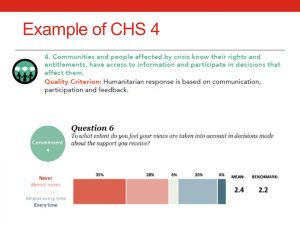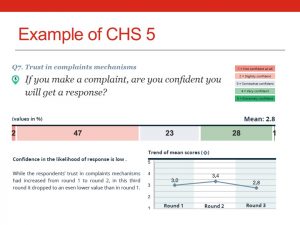Can affected people’s perceptions help us improve programming?
In this blog, Grethe Markussen introduces three videos produced by the Listen Learn Act (LLA) Project to show how perceptional surveys bring NGOs new insight about programme quality and accountability to affected people.
The short answer is yes! Learning from the Listen Learn Act (LLA) Project shows that perceptional surveys bring NGOs new insights about programme quality and accountability to affected people, and they help us understand how compliant we are with the CHS in the eyes of affected people.
In just 10 minutes, you can watch some of the learning that came out of the LLA Project. Two short 4-5 minutes videos from Lebanon and Mali provide interested practitioners a brief introduction to the project and how the process was perceived by some of the NGO participants and affected people. You can watch the Lebanon video here, the Mali video (in English) here and in French here.
More about the Listen Learn Act Project
LLA is a quality and accountability project, which set out to test and enhance the roll-out of the CHS. By applying the Constituent Voice (CV) methodology, LLA tracked over time how affected populations perceive humanitarian organisations’ commitment to and implementation of the CHS, including their ability to place affected people at the centre of their operations. Working with 15 organisations, the project gained insight into the opportunities and challenges of applying the methodology across four different humanitarian contexts: the conflict in Northern Mali, Earthquake in Nepal, South Sudanese refugees in Ethiopia, and the Syria crisis response in Lebanon. The project was implemented by a consortium of DanChurchAid (lead), Save the Children Denmark and Ground Truth Solutions from September 2015-June 2017.
Ground Truth’s CV methodology was used to ask disaster-affected people a few questions about their satisfaction with organisational services and support linked to the CHS commitments, in particular to commitments: 1, 2, 3, 4, 5 and 8. The visual representation of the results allowed performance and improvement tracking over time through analysis and discussion with communities, and within NGOs to identify potential reasons for dissatisfaction and ideas for solutions. The process enabled the NGOs to course correct based on the feedback, and to close feedback loops between survey rounds. It ensured that people heard back about how the organisations had planned to address their concerns and were able to bring their voices to decision-making processes about the assistance provided to them.


What added value do people’s perceptions bring accountability efforts?
Feedback survey methods, like the Constituent Voice methodology, help us take the temperature of our performances and identify and prioritize improvement areas. They also provide us with real-time actionable data that enables us to straight away listen to, learn from and act on the data collected. The method is systematic collecting data on a regular basis with time in-between surveys to discuss results with affected people, listen to their views on how to fix issues of concern and thereby close feedback loops and take actions to course correct. In the LLA project, organisations had 2-3 months in-between survey rounds to close feedback loops and take corrective actions, if required. Perceptional data does not stand alone, but when triangulated with other information sources it can deepen our understanding of how communities want us to engage with them.
What did the project reveal in terms of organisational CHS compliance?
LLA was in many ways an ‘eye opener’ for the participating organisations and consortia partners. Although the survey results differed from country to country and between organisations, some trends emerged. Individual survey reports showed that affected people were generally satisfied with the services provided (CHS 1), the timeliness of interventions (CHS 2) and the capacity building or awareness raising activities received to empower them (CHS 3). Communities also felt that NGO staff were generally treating them with respect (CHS 8). However, surprisingly, some of the lowest scores were registered for CHS 4 (access to information & participation) and CHS 5 (access to complaint systems). Community members did not feel that they had a say in decision-making processes and they lacked information about how to make a complaint despite intense organisational investment in hotlines and suggestion boxes. In addition, many respondents felt unsure about whether or not they would get a reply, if they were to make a complaint. Women and children had the lowest information levels about existing complaint mechanisms, and also seemed hesitant to use these mechanisms. Some women even described the mechanisms as ‘culturally inappropriate’. This seems to suggest that we have to reconsider if our feedback mechanisms provide access to, and capture voices from a representative group of affected people – and how to make our information sharing mechanisms more inclusive to live up to our obligations under CHS 4 and 5. The final learning report from the consultant Andy Featherstone can be downloaded under ‘Learning together’ at DCA’s online learning portal: ActLearn.org
What does it take to make accountability systems inclusive and to ensure real change for affected people?
The response varies from organisation to organisation and from context to context, but in general, LLA makes the following recommendations:
Firstly, complaint mechanisms cannot stand alone as the only way to receive feedback from affected people. We need a proactive accountability system that is cultural, age and gender appropriate and reach out to the “hardest to reach” including; women, children, elderly, minority groups, people living with disabilities, those with lower literacy levels, or others, who are less likely to use suggestion boxes or hotlines. The Constituent Voice methodology offers proactivity, representation, systematic and scale.
Secondly, the visual representation of our findings is crucial to guide management decision. Across the 15 participating organisations, simple graphical representation of the survey findings was seen as a key contributing factor to guide decision-making and follow-up.
Thirdly, we need to close feedback loops and course correct. LLA’s final learning report reminds us to feedback to communities about how we have used their responses to inform decision-making. Alternatively, organisations run the risk of creating survey fatigue, mistrust and disrespect.
Want to know more?
You can find more information about the LLA Project at ActLearn.org
You can also access the free LLA online training course directly under ‘Resources’ at the CHS webpage.
Videos
LLA video from Mali – English version
LLA video from Mali – French version
LLA video from Lebanon

